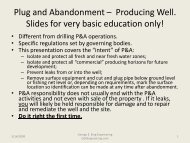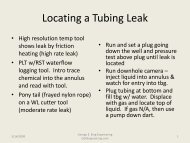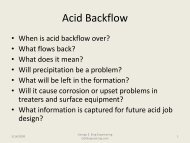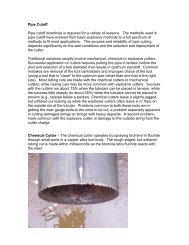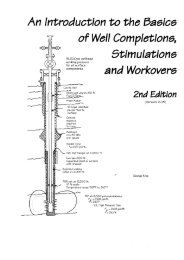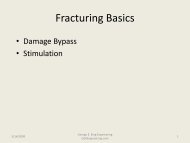Addressing the Environmental Risks from Shale Gas Development
Addressing the Environmental Risks from Shale Gas Development
Addressing the Environmental Risks from Shale Gas Development
Create successful ePaper yourself
Turn your PDF publications into a flip-book with our unique Google optimized e-Paper software.
drillers reportedly encountered an unexpected pocket of methane in an abandoned coal mine onlyabout 1,000 feet below <strong>the</strong> surface, and a blowout preventer had not yet been installed. 29Such disasters stress <strong>the</strong> need for ga<strong>the</strong>ring accurate information about <strong>the</strong> subsurface andensuring that personnel on drill sites are trained to deal with unusual and unexpected situations,including blowouts. Even if drilling and well construction are carried out in full compliance withlocal, state, and federal regulations, and industry best practices are followed, many decisionsduring drilling and fracturing operations must be made by individuals, and training andexperience, toge<strong>the</strong>r with full enforcement of strong regulations and adoption of industry bestpractices, are critical to <strong>the</strong> protection of <strong>the</strong> public and <strong>the</strong> environment.Seismic <strong>Risks</strong>Ano<strong>the</strong>r subsurface risk that has received attention recently is <strong>the</strong> possibility that drilling andhydraulically fracturing shale gas wells might cause low-magnitude earthquakes. In 2008 and2009, <strong>the</strong> town of Cleburne, Texas, experienced several clusters of weak earthquakes allregistering 3.3 or less on <strong>the</strong> Richter scale. 30 Since <strong>the</strong> town had never registered an earthquake inits 142-year history, some residents wondered if <strong>the</strong> recent increase in local drilling activityassociated with <strong>the</strong> Barnett <strong>Shale</strong> might be responsible. A study by seismologists with <strong>the</strong>University of Texas and Sou<strong>the</strong>rn Methodist University found no conclusive link betweenhydraulic fracturing and <strong>the</strong>se earthquakes but indicated that <strong>the</strong> injection of waste water <strong>from</strong>gas operations into numerous saltwater disposal wells that were being operated in <strong>the</strong> vicinitycould have caused <strong>the</strong> seismic activity. 31 Over 200 such wells exist in <strong>the</strong> Barnett <strong>Shale</strong>, and are<strong>the</strong> preferred means of waste water disposal for operators in <strong>the</strong> area. 32While <strong>the</strong> hydraulic fracturing process does create a large number of microseismic events, ormicro-earthquakes, <strong>the</strong> magnitudes of <strong>the</strong>se are generally too small to be detected at <strong>the</strong> surface.Figure 4C shows <strong>the</strong> cumulative frequency distribution of microseismic events of different sizein a Barnett <strong>Shale</strong> well. Altoge<strong>the</strong>r, a downhole seismometer array deployed in a nearby welldetected about 1,000 micro-earthquakes. The biggest micro-earthquakes have a magnitude ofabout -1.6. An earthquake of this size represents slip of less than a hundredth of an inch, about<strong>the</strong> thickness of a human hair, on a pre-existing fault only a couple of feet across. The number ofextremely small earthquakes (less than a magnitude of about -2.8) tapers off because <strong>the</strong>y are sosmall that <strong>the</strong>y cannot be detected.Underground fluid injection is an integral part not only of hydraulic fracturing, but of wastewater disposal in injection wells, some geo<strong>the</strong>rmal energy projects, and carbon dioxidesequestration. The seismic monitoring of hydraulic fracture jobs discussed earlier is critical toimproving understanding of how underground injection might spark unexpectedly highmagnitudeseismic activity.Surface Water and Soil ContaminationBecause of <strong>the</strong> quantities of chemicals that must be stored at drilling sites and <strong>the</strong> volumes ofliquid and solid waste that are produced, significant care must be taken that <strong>the</strong>se materials donot contaminate surface water and soil during <strong>the</strong>ir transport, storage, and disposal.9






